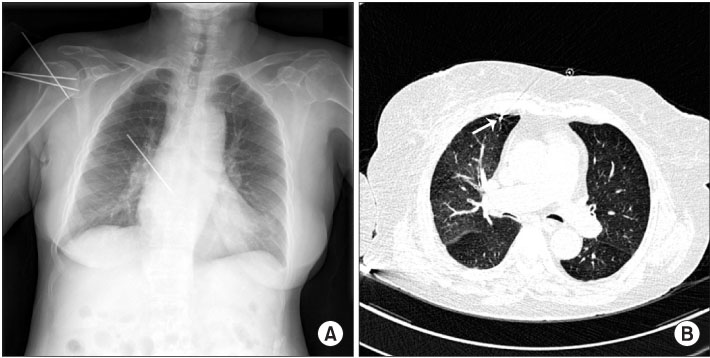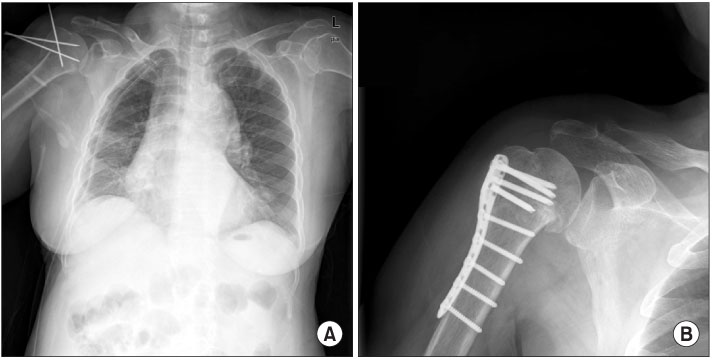J Korean Orthop Assoc.
2011 Apr;46(2):167-171.
Early Intrathoracic Migration of K-wire Used for Fixation of Proximal Humerus Fracture
- Affiliations
-
- 1Department of Orthopedic Surgery, Pusan National University School of Medicine, Pusan, Korea. scheon@pusan.ac.kr
Abstract
- We report a case of early intrathoracic migration of Kirshner wire (K-wire), which had been-used for fixation of proximal humerus fracture. A 74 year-old-woman visited the emergency room due to sudden onset of dyspnea. A chest x-ray and CT scan taken at the emergency room demonstrated 3 K-wires that had been applied to the proximal humerus fracture, 1 K-wire in the anterior chest wall, and mild pneumothorax of the right lung. An emergency removal of K-wire using thoracoscopy was performed and a chest tube was inserted for the treatment of pneumothorax during thoracic surgery. We removed residual 3 K-wires from the right proximal humerus and fixed right proximal humerus fracture by open reduction and internal fixation using a proximal humerus locking plate. We think that if a proximal humerus fracture is fixed using smooth K-wire, patients require close follow-up with the use of x-ray until the K-wire has been removed, in addition, it is very important to take steps to prevent K-wire migration.
MeSH Terms
Figure
Reference
-
1. Mazet R Jr. Migration of a kirschner wire from the shoulder region into the lung: report of two cases. J Bone Joint Surg Am. 1943. 25:477–483.2. Lyons FA, Rockwood CA Jr. Migration of pins used in operations on the shoulder. J Bone Joint Surg Am. 1990. 72:1262–1267.
Article3. Fuster S, Palliso F, Combalia A, Sanjuan A, Garcia S. Intrathoracic migration of a Kirschner wire. Injury. 1990. 21:124–126.
Article4. Freund E, Nachman R, Gips H, Hiss J. Migration of a Kirschner wire used in the fixation of a subcapital humeral fracture, causing cardiac tamponade: case report and review of literature. Am J Forensic Med Pathol. 2007. 28:155–156.5. Mellado JM, Calmet J, García Forcada IL, Saurí A, Giné J. Early intrathoracic migration of Kirschner wires used for percutaneous osteosynthesis of a two-part humeral neck fracture: a case report. Emerg Radiol. 2004. 11:49–52.
Article6. Sergides NN, Nikolopoulos DD, Yfadopoulos DK, Novi EA, Kanata MP. Intrathoracic migration of a Steinman wire: a case report and review of the literature. Cases J. 2009. 2:8321.
Article7. Rowe SM, Lee WS. Migration of metal fixatives from the acromioclavicular joint into the neck (report of two cases). J Korean Orthop Assoc. 1986. 21:499–501.
Article8. Ha SH, You JW, Lee SH, Shin DM, Pyo YB. Migration of kirschner-wires from the acromioclavicular joint into the neck: report of 2cases). J Korean Orthop Assoc. 1994. 29:1264–1267.9. Song TJ, Song JY, Kim SK, Park JH, Wang JH, Park JW. Intrathoracic migration of K-wire after fixation of proximal huemrus fracture: case report. J Korean Fract Soc. 2005. 18:462–465.
Article10. Sarper A, Urgüden M, Dertsiz L, Demircan A. Intrathoracic migration of Steinman wire. Interact Cardiovasc Thorac Surg. 2003. 2:210–211.
Article
- Full Text Links
- Actions
-
Cited
- CITED
-
- Close
- Share
- Similar articles
-
- Intrathoracic Migration of K-wire after Fixation of Proximal Huemrus Fracture: Case Report
- A Operative treatment of the three-part, four-part Fracture and Fracture dislocation in proximal humerus
- Inlay Fibular Autograft and Helical LCP Fixation for a Segmental Comminuted Fracture of the Osteoporotic Proximal Humerus: A Case Report
- Treatment of Surgical Neck Fracture and Fracture Dislocation in Proximal Humerus
- Unusual Migration of Kirschner's Wire into Intervertebral Foramen after Lateral Clavicle Fracture Fixation: A Case Report




